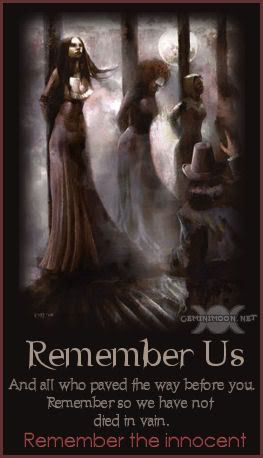← Mentorships
Burning Times
The Witch trials in the Early Modern period were a period of witch hunts between the fifteenth and eighteenth centuries, when across Early Modern Europe, and to some extent in the European colonies in North America, there was a widespread hysteria that malevolent Satanic witches were operating as an organized threat to Christendom. Those accused of witchcraft were portrayed as being worshippers of the Devil, who engaged in such acts as malevolent sorcery, and orgies at meetings known as Witches' Sabbaths. Many people were subsequently accused of being witches, and were put on trial for the crime, with varying punishments being applicable in different regions and at different times.
The witch trials originated in south-eastern France during the fourteenth century, before spreading through central Europe and then into other parts of the continent and also amongst European colonies in North America. While early trials fall still within the Late Medieval period, the peak of the witch hunt was between 1580 and 1630. The last known trial occurred in 1782. Amongst the most well known of these trials was the Scottish North Berwick witch trials, Swedish Torsåker witch trials and the American Salem witch trials. Among the largest and most notable was the Trier witch trials (1581–1593), the Fulda witch trials (1603–1606), the Würzburg witch trial (1626–1631) and the Bamberg witch trials (1626–1631). Over the entire duration of the phenomenon of some four centuries, an estimated total of 40,000 to 60,000 people were executed.
Historians and other scholars have long debated the reasons for the witch trials. The majority of historians concur that there never were any such organised group of witches. Mainstream historiography sees the reason for the witch craze in a complex interplay of various factors that mark the Early Modern period, including the religious sectarianism in the wake of the Reformation, besides other religious, societal, economic and climatic factors. Feminist and Neopagan authors have however portrayed them as either being an attempt by the patriarchal authorities to subjugate women, or as the persecution of an actual Witch-Cult, which had been pagan, rather than satanic, in nature. Neither of these have been accepted by mainstream historians who have specialised in the subject of the witch trials, such as Norman Cohn, Keith Thomas, Carlo Ginzburg, Robert W. Thurston and Brian Levack.

NEW MEMBERS
Leech (2)
08:02 - November 17 2024

Leech (2)
06:03 - November 17 2024

Whelp (1)
16:52 - November 16 2024
REAL VAMPIRES LOVE VAMPIRE RAVE
Vampire Rave is a member of
Page generated in 0.0517 seconds.





